Indexed In
- Open J Gate
- RefSeek
- Hamdard University
- EBSCO A-Z
- OCLC- WorldCat
- Publons
- International Scientific Indexing
- Euro Pub
- Google Scholar
Useful Links
Share This Page
Journal Flyer

Open Access Journals
- Agri and Aquaculture
- Biochemistry
- Bioinformatics & Systems Biology
- Business & Management
- Chemistry
- Clinical Sciences
- Engineering
- Food & Nutrition
- General Science
- Genetics & Molecular Biology
- Immunology & Microbiology
- Medical Sciences
- Neuroscience & Psychology
- Nursing & Health Care
- Pharmaceutical Sciences
Research Article - (2021) Volume 10, Issue 2
Integration of Remote Sensing and Geological Mapping for Economic Mineralization Mapping in Mwitika-Makongo Area, Kitui Country
Githenya LK1*, Mathu EM1, Kariuki PC1 and Waita J22Ministry of Mining and Petroleum, Kitui, Kenya
Received: 03-Feb-2021 Published: 24-Feb-2021, DOI: 10.35248/2469-4134.21.10.281
Abstract
This study integrates geology with remote sensing techniques to establish geological structures and their associated economic mineralization in the rocks of Mwitika-Makongo area. The objective of this study was to map hydrothermally altered zones from Landsat 8/OLI of the study area and validate the results with geological mapping. The remote sensing methods included; band combinations, band ratios and lineament extraction. Geological methods consisted of, field mapping and geochemical analysis. The integrated techniques resulted in lithological discrimination of hydrothermally altered zones. Geological field mapping and geochemical investigations led to the interpretation of some iron mineralization in hydrothermally altered zones, especially around Kalima Kathei. It also led to the conclusion that lineaments control drainage patterns in the area. Chemical analysis using X-Ray fluorescence, for mineralized samples followed by Pearson correction matrix of the chemical data gave a strong correlation between Fe2O3, TiO2 and P2O5 indicating that their mode of delivery in the area could be similar, with a likely source from hydrothermal fluids in the area. These results confirmed the findings from remote sensing studies on hydrothermal alteration. It was therefore concluded that integration of remote sensing techniques and geological field mapping provide a tool for delineating economic mineralization in Neoproterozoic rocks.
Keywords
Remote sensing; Neoproterozoic; Landsat-8/OLI; X-Ray fluorescence
Introduction
The Mwitika-Makongo study area occurs within the Neoproterozoic metamorphic belt rocks of Kitui East sub-county. Previous geological surveys within the area have established the occurrence of several mineral resources of economic potential like iron ore, magnetite and coal. However, these previous geological surveys were conducted using field observations and limited use of technology. This has led to a vast majority of the area’s local geology being poorly understood. With the current advancement in technology, unearthing the details of the area local geology could be key to unlocking the vast mineral potential and exploration prospectivity.
The current advancement in Remote Sensing technology like the introduction of Landsat-8/OLI with a higher number of bands and narrow bandwidth has led to an improvement in geological mapping. This study integrates the use of Remote Sensing techniques and geological field mapping in delineating economic mineralization in rocks of the study area. Specific objectives of this study was to; (i) Map hydrothermally altered zones from satellite imagery (ii) Extract lineaments from Landsat-8/OLI bands of the Mwitika-Makongo area, (iii) Geologically map zones highlighted from satellite imagery as economically mineralized, and (iv) Validate the results from remote sensing investigations with those obtained from the geochemical analysis.
An image subset of Landsat-8/OLI data year 2019 scenes LC81670612019025LGN00 was downloaded from the USGS website page. The downloaded data was processed using ENVI 5.3 and ArcGIS 10.5 software. The satellite image processing techniques such as Color composite and band rationing were applied to achieve the main purpose of this study. To validate on the results from satellite imagery, rock and mineral samples collected during geological field mapping were analyzed in the laboratory to ascertain their economic potential.
Materials and Methods
The study area is located in Kitui County about 160 km east of Nairobi City. The Mwitika-Makongo study area is bounded by longitudes 38° 18' E to 38° 26' E and latitudes 1° 22' S to 1° 32' S, covering an approximate area of 100 Km2 (Figure 1). This area can be accessed from Nairobi through the Thika-Kitui-Zombe road or the Machakos-Kitui-Zombe road. The study area is located to the eastern side of Zombe town and is easily accessed through a murram road that is regularly graded.
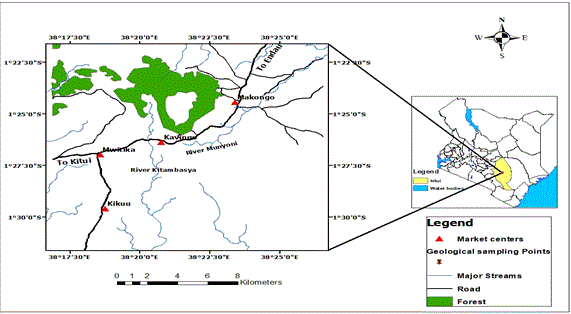
Figure 1: The location of the study area in Kenya.
To achieve the study objectives, materials and methods from remote sensing, geological mapping and geochemical investigations were used.
Remote sensing
Remote sensing is the collection of information about an object or area without being in physical contact with it. Satellite remote sensing remains one of the best techniques for mapping not only the geology of a place but also the associated structures [1].
To map hydrothermally altered zones and extract lineaments of the study area, digital satellite imagery (Landsat 8/OLI) from USGS was used. Image analysis was done using ENVI 5.3 and ArcGIS 10.5. PCI geomatics 2016 was used for extraction of lineaments.
Geological mapping
To identify lithological units that were highlighted from satellite imagery as economically mineralized, the researcher carried out geological field mapping and sample collection of rocks and minerals in the area. Samples were collected along several traverses in a grid on foot. Fresh rock and mineral samples were collected and packaged in bags for further analysis in the laboratory.
Geochemical analysis
For this research work to indicate the quality of potential economic rocks and minerals in the study area, samples were collected from areas selected from satellite imagery as mineralized. The geochemical analysis was through X-ray fluorescence (XRF). This was done in the laboratory of the Ministry of Mining and Petroleum in Kenya. Samples were prepared by pulverizing using a pulverizing machine (laboratory pulverizer) to grains of 100 microns in diameter. After pulverization, the samples were packed, sealed and taken through chemical analyses. This was done to find out the presence and concentration of major and trace elements of the analysed samples.
Results
Remote sensing investigation
Color Composite Band Combination: Several different spectral bands of Landsat-8/OLI data were selected and combined in an RGB Color system. Bands 5,6,7 (Figure 2) composite was used to discriminate hydrothermally altered zones. In false-Color image 5,6,7 red Color represents healthy vegetation, the light blue Color represents outcrops, bare land and sands, the dark blue Color represents hydrothermally altered rocks, and the light green represents unhealthy vegetation.
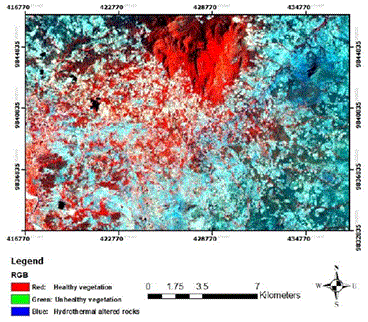
Figure 2: FCC RGB bands (5,6,7) dark blue color represents hydrothermally altered rocks.
Band Ratio Combination: To enhance hydrothermally altered rocks in Neoproterozoic Mozambique rocks of the study area, band rationing was performed. Different band ratios were combined and assigned to RGB. The most appropriate ratio combination was found to be (4/2, 6/7, 6/5). Image incorporation of bands 4/2, 6/7 and 6/5 was used to discriminate altered from unaltered outcrop and highlight areas where intrusive rocks occur. In Figure 3, the blue Color represents altered rocks in the study area.
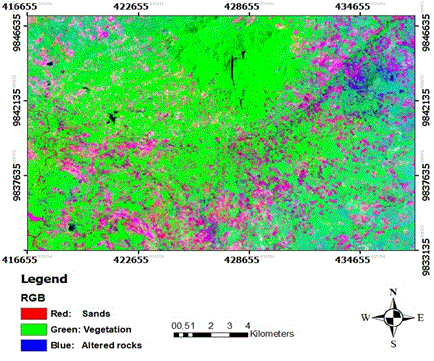
Figure 3: FCC band ratio (4/2, 6/7 and 6/5) RGB, the blue color represents altered rocks in the NE part of the satellite map.
Lineament extraction: The automatic lineament extraction from Landsat 8/OLI bands of the study area was performed under line extraction parameters of PCI Geomatica 2016. The first principal component image (PC1) of Landsat 8 pansharpened reflected bands had good visualization of linear features due to it carrying most information from all the bands. PC1 was therefore preferred and suitable for lineament extraction. The obtained total lineaments from automatic lineament extraction from PC1 were visually edited to extract only the structural lineaments that were necessary for this study (Figure 4).
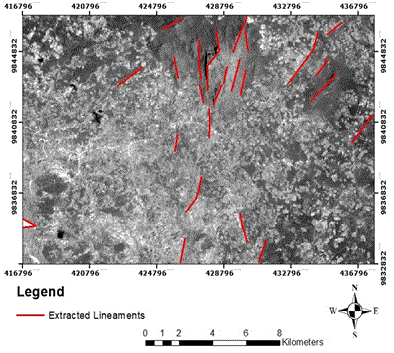
Figure 4: Lineament map of Mwitika-Makongo area.
Geological mapping
The Mwitika-Makongo area was identified as a medium to highgrade metamorphic terrane with a North-South general structural trend. The rocks of the Makongo area are almost entirely of Neoproterozoic Mozambique Belt origin. They include the granitoid gneisses, metamorphosed psammitic rocks like quartzites and metamorphosed semi-pelitic like the biotite gneisses. Sandy soil deposits of Pleistocene and Recent Age, which include red and black soils are also found in various localities. On the local scale, granitoid gneisses and migmatites are the dominant rocks. Biotite gneisses, hornblende-biotite gneisses and quartz-feldspar-biotite gneisses occupy few areas.
Intrusive rocks like gabbros and pyroxenites also occur as intercalations.
The geological structures of Mwitika-Makongo area include structures like foliation planes, lineations, folds, faults, pegmatites, veins and joints. Majority of the faults observed were confined within Makongo hill (Plate 1). The hill is highly faulted in all sides but major fault lines were observed on the western and eastern parts. During geological field mapping, it was ascertained that majority of the streams in the area flow through fracture zones and fault lines. This confirmed the observations from satellite imagery that drainage pattern in the area are guided by lineaments.
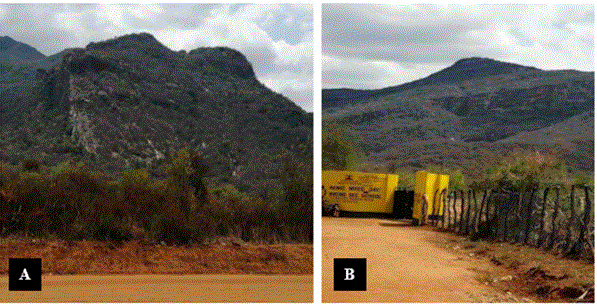
Plate 1: (A) Normal fault observed at Ngaaka yakwa with a dipping hanging wall, (B) Graben formed from faulting on the eastern side of Makongo hill (UTM: 430874/9844238).
Various economic mineral resources were found in the study area. They include iron ore, magnetite, gemstones, and feldspars. Economic mineral deposits of iron ore and magnetite were conspicuously found in areas highlighted by satellite imagery as hydrothermally altered at Kalima Kathei hill (Plate 2).
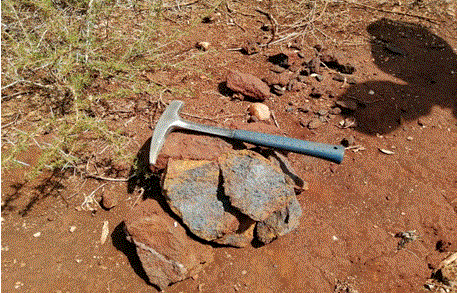
Plate 2: Hammered iron ore sample at Kalima Kathei.
Geochemical analysis
X-Ray Fluorescence method was used to analyze major, minor and trace elements from the rock samples collected from the study area. The major elements are given in weight per cent. Pearson correction coefficients were used to test the dependence between the ten major geochemical elements. The Pearson correlation matrix results were plotted using MS Excel (Table 1). From this matrix, a positive correlation between two elements means that their mode of delivery into the rocks of the study area is similar.
| SiO | Al2 | Fe2 | CaO | Mg | Mn | Na2 | K2O | TiO | P2O | |
|---|---|---|---|---|---|---|---|---|---|---|
| 2 | O3 | O3 (Tot |
O | O | O | 2 | 5 | |||
| al | ||||||||||
| Iron | ||||||||||
| ) | ||||||||||
| SiO | 1 | |||||||||
| 2 | ||||||||||
| Al2 | 0.32 | 1 | ||||||||
| O3 | 786 | |||||||||
| Fe2 | -0.5 | -0.3 | 1 | |||||||
| O3 | 585 | 628 | ||||||||
| (Tot | 8 | 1 | ||||||||
| al | ||||||||||
| Iron | ||||||||||
| ) | ||||||||||
| Ca | -0.5 | -0.15 | -0.3 | 1 | ||||||
| O | 205 | 821 | 563 | |||||||
| 1 | ||||||||||
| Mg | -0.0 | 0.10 | -0.2 | 0.12 | 1 | |||||
| O | 720 | 755 | 344 | 6113 | ||||||
| 2 | 3 | 4 | ||||||||
| Mn | -0.01 | -0.14 | 0.11 | -0.01 | -0.2 | 1 | ||||
| O | 832 | 049 | 665 | 427 | 3471 | |||||
| 2 | ||||||||||
| Na2 | 0.37 | 0.02 | -0.13 | -0.2 | -0.18 | -0.15 | 1 | |||
| O | 789 | 384 | 613 | 878 | 946 | 498 | ||||
| 3 | 8 | 4 | ||||||||
| K2O | 0.64 | 0.25 | -0.3 | -0.37 | -0.2 | -0.3 | 0.33 | 1 | ||
| 168 | 093 | 543 | 206 | 917 | 848 | 469 | ||||
| 2 | 9 | 7 | 1 | 9 | ||||||
| TiO | -0.4 | -0.2 | 0.59 | -0.2 | -0.14 | 0.12 | 0.04 | -0.2 | 1 | |
| 2 | 586 | 678 | 344 | 5174 | 293 | 468 | 161 | 478 | ||
| 7 | 5 | 9 | 8 | 4 | ||||||
| P2O | -0.3 | -0.2 | 0.63 | -0.0 | -0.37 | 0.29 | -0.2 | -0.19 | -0.0 | 1 |
| 5 | 8166 | 978 | 244 | 0187 | 353 | 494 | 944 | 746 | 990 | |
| 7 | 8 | 1 | 8 |
From these analyses, it is noted that SiO2 correlates negatively with Fe2O3Total, CaO, MgO, MnO, TiO2 and P2O5. This means that their delivery mode in the Mwitika-Makongo study area is not similar. A strong correlation was noted between Fe2O3Total, TiO2 and P2O5 indicating that their mode of delivery in the area could be similar, with a likely source from hydrothermal fluids whose source is magmatic intrusions in the area.
Discussion
Interpretation of the results from Color composite was compared with other research findings on hydrothermal alteration mapping [2] used Color composite bands 5,6,7 in mapping hydrothermal altered rocks. The altered rocks appeared as blue and were related to gold mineralization [3] used bands 5,6 and 7 when mapping for hydrothermal alteration zones in Eburru. His research work highlighted areas in blue Color as hydrothermally altered, hence related to geothermal activity in the area. Color composite bands of Landsat 8/OLI to highlight areas of Neoproterozoic belt rocks as hydrothermally altered in blue Color. It is evident from this research work and others that have previously been carried out, that Color composite can be used to map hydrothermally altered zones and mineralized areas [4].
Band ratio has been successfully used in mapping hydrothermal alteration zones, [3-6]. Lineaments can also be extracted from satellite images using both manual visualization and automatic lineament extraction through software such as PCI GeoAnalyst, Geomatica and Matlab. GeoAnalyst-PCI package to extract structural lineaments in Ikutha area. Through geochemical analysis and Pearson correlation of major elements, showed that iron in Ikutha came from hydrothermal/magmatic source due to its negative correlation with materials of the host rock. In this study, it has therefore been illustrated that remote sensing techniques can be used to supplement geological field mapping in delineating zones of economic mineralization [7,8].
Conclusion
Satellite remote sensing is one of the best techniques for mapping geological structures and mineralized zones. This is because of its ability to capture data at different bands using the reflectance energy from objects on the ground based on their unique spectral signatures. A major challenge exists in interpretation because it requires human intervention. Since different people could interpret different features differently, ground-truthing is therefore a critical stage.
The study concludes that the use of Landsat 8/OLI was an effective method of mapping economic mineralized zones and geological structures in the Mwitika-Makongo area. Through band composite, the study showed a significant relationship between hydrothermally altered rocks and economic minerals like iron ore and magnetite. Ground trothing through geological field mapping and geochemical analysis supplemented on the results from remote sensing that iron ore in the area is from hydrothermal alteration. The results from geochemical analysis validated those of remote sensing that mineralization in the area is by hydrothermal alteration as Fe2O3, P2O5 and TiO2 had a strong correlation. The use of remote sensing techniques has therefore proved that they provide a considerable degree of accuracy in mapping economic mineralized areas and therefore supplement on geological mapping.
This study recommends the use of high-resolution imagery like Aster with 14 bands that are adequate in mapping small differences in geological units because of the wider spectrum the bands cover. Geophysical survey should be conducted around the Kalima Kathei area to ascertain the quantity of the economic mineralized resources like iron ore and magnetite. A further geological investigation should be carried out around Makongo hill to establish the cause of the numerous faults around the hill. A hydrogeological survey should be conducted around Makongo hill to gauge the area’s groundwater potential given that the area is classified as semiarid.
Conflict Of Interests
The authors confirm that this manuscript has not been published elsewhere and is not under consideration by any journal. The authors, therefore, declare that there is no conflict of interest.
Acknowledgement
The research was made possible with the full education scholarship from the Graduate Teaching Assistant program at South Eastern Kenya University (SEKU). The author is grateful to the university for the scholarship and all the assistance accorded through members of the Department of Geology and Meteorology.
REFERENCES
- Chasia AS. Mapping geological structures in western mutomo, Kitui County: A remote sensing approach. Uni Nairobi. 2014;9(2):11-25.
- Frutuoso R. Mapping hydrothermal gold mineralization using Landsat 8 data. A case of study in Chaves license, Portugal. Intern J Geosci. 2015;12:83-85.
- Omwenga B. Use of space-borne imageries in mapping of hydrothermal alteration zones and geological structures in the eburru geothermal complex, Kenya. Geothermal Conf. 2018;11:1-14.
- Githenya LK, Kariuki PC, Waswa AK. Application of remote sensing in mapping hydrothermal alteration zones and geological structures as areas of economic mineralization in Mwitika-Makongo Area, SE Kenya. J Env Earth Sci. 2019;13(2):11-22.
- Kujjo CP. Application of remote sensing for gold exploration in the Nuba Mountains, Sudan. Bowling Green State University, USA. 2010.
- Achieng J, Mutua J, Mibei G, Olaka L, Waswa AK. Mapping of hydrothermal minerals related to geothermal activities using remote sensing and GIS: Case Study of Paka Volcano in Kenyan Rift Valley. Intern J Geosci. 2017;8(5):711-725.
- Waswa A, Aaron KM, Nyamai CM, Mathu E. Integration of geological mapping and remote sensed studies for the discovery of iron-ore mineralization in Mutomo-Ikutha Area, SE Kenya. Uni J Geosci. 2015;3(2):39-50.
- Waswa A, Aaron K. Petrology and iron ore mineralization in the neoproterozoic mozambique belt rocks Of Mutomo-Ikutha Area, Kitui County, S.E. Kenya. University of Nairobi, Kenya. 2015.
Citation: Githenya LK, Mathu EM, Kariuki PC, Waita J (2021) Integration of Remote Sensing and Geological Mapping for Economic Mineralization Mapping in Mwitika-Makongo Area, Kitui County. J Remote Sens GIS. 10:281.
Copyright: 2021 Githenya LK, et al. This is an open-access article distributed under the terms of the Creative Commons Attribution License, which permits unrestricted use, distribution, and reproduction in any medium, provided the original author and source are credited.

